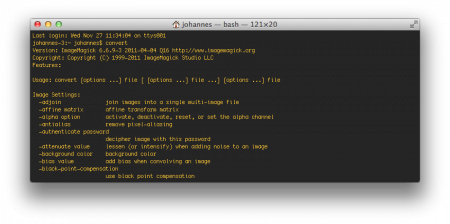

LIBS = -lMagickCore-Q16 -llcms -ltiff -lfreetype -ljpeg -lfontconfig -lXext MAGICK_LDFLAGS = -L/usr/local/lib -lfreetype Ghostscript lib -with-gslib=yes no (failed tests)ĬFLAGS = -fopenmp -g -O2 -Wall -W -pthread Ghostscript fonts -with-gs-font-dir=default

Host system type: x86_64-unknown-linux-gnuīuild system type: x86_64-unknown-linux-gnu For example, here is a recent report from our system: ImageMagick is configured as follows. Pay particular attention to the last lines of the script output. Watch the configure script output to verify that it finds everything that If you are willing to accept configure's default options, and build from within the source directory, you can simply type: $ cd ImageMagick-7.0.10-62 $. stdlib.h), and if any delegate libraries are available for ImageMagick to use (e.g. This includes finding a compiler, where your compiler header files are located (e.g. The configure script looks at your environment and decides what it can cobble together to get ImageMagick compiled and installed on your system. Now that you have the ImageMagick Unix/Linux source distribution unpacked, let's configure it.

Unpack the distribution it with this command: tar xvzf Download from or a mirror and verify the distribution against its message digest. A compiler is required and fortunately almost all modern Unix systems have one. ImageMagick builds on a variety of Unix and Unix-like operating systems including Linux, Solaris, FreeBSD, Mac OS X, and others. However, if you want to customize the configuration and installation of ImageMagick under Unix or Linux systems, lets begin.
#IMAGEMAGICK FOR MAC OS X INSTALL#
If so, you also have the option of installing a pre-compiled binary release or if you still want to install from source without all the fuss see the simple Install From Source instructions. It's possible you don't want to concern yourself with advanced installation under Unix or Linux systems.


 0 kommentar(er)
0 kommentar(er)
